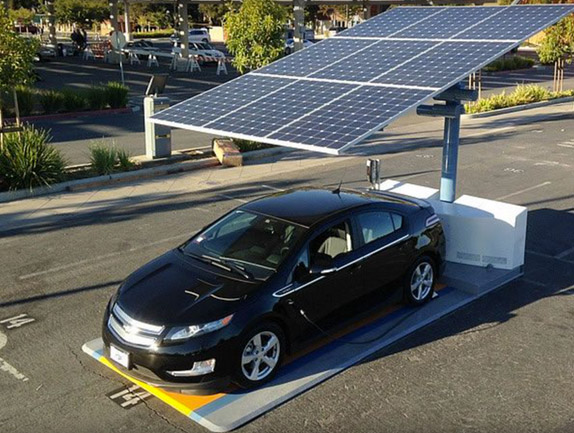
For the last several decades, the fuel consumption requirements imposed on vehicle manufacturers in Canada were the same as those applied in the US. The premise of the Conservatives and Liberals alike has always been that Canada has no choice but to emulate the US, because Canada is part of an integrated North American market.
That line of thinking is half right. Canada is part of an integrated North American market but to date, vehicle manufacturers have gotten off easier in Canada than in the US and Canada does have option of more stringent stipulations within the North American framework.
Understanding CAFE
To put the above considerations in context, thus far, what has been the same in Canada as in the US are the obligations that each vehicle manufacturer must comply with corporate average fuel economy (CAFE) standards – standards which each year incrementally decrease the required average fuel consumption of vehicles sold.
These CAFE standards are sales-weighted, which is to say, that a CAFE year-specific goal represents the mandatory minimum average fuel consumption for all vehicles sold by a given manufacturer, in a given country, in a given year. Thus, the greater the proportion of sales associated with high-energy-consuming models, the worse will be a manufacturer’s CAFE and the more difficult it will be for the manufacturer in question to comply with the CAFE standard for that year.
At least, this is the way things stand prior to 2016.
Loopholes open up for car makers
The new US CAFE legislation, which comes into effect for the 2016 to 2025 period, is written in a way that allows a corporate compliance target to be a moving target. That is, should the manufacturer sell a “higher than expected” number of larger (higher fuel consumption) vehicles, that manufacturer would be have the “privilege” of having a higher than desired average fuel consumption compliance target.
Unfortunately, Canada has adopted the above-described new US CAFE formula, while continuing to leave more wiggle room for manufacturers under the Canadian CAFE rules than under its US counterpart. As a result, the Canadian approach risks encouraging the dumping/marketing of the larger vehicles on the Canadian market.
By contrast, there are options for Canada to have more stringent requirements than the US, without any of the constraints associated with the integrated North American market, and remaining consistent with the actions of 8 US states.
Canadian fuel efficiency hugely exaggerated
The fuel consumption figures used to determine a manufacturer’s compliance or non-compliance with CAFE targets are not the same in the US and Canada. The Canadian numbers highly exaggerate what one can expect on the road, while the US numbers are not far off from what the consumer can expect under SUMMER driving conditions.
In the US, the formula for churning out the numbers is based on a combination of test results that are subject to mathematical calibrations to reflect the on the road experiences of consumers.
Furthermore, in the US, though the manufacturers are responsible for doing the testing, to keep them honest, the US Environmental Protection Agency randomly tests about 15% of the models. This aspect of the US system seems to work quite well.
However, in Canada, the manufacturers do their own testing and their data is not verified by the Government of Canada. This is how we end up with vehicles rated as having exceptionally better fuel economy in Canada than the very same models in the US.
The implications are: 1) the calculation of a manufacturer’s year-specific Canadian CAFE is not reliable; 2) it is easier for a manufacturer to comply with a Canadian CAFE target for the year in question than it is to comply with the identical US CAFE target for the same year; and 3) Canadian consumers are mislead as to the fuel consumption to be expected for the models on our market.
With regard to the latter point, knowing that the fuel consumption ratings claimed by the manufacturers via their advertising are not credible, Canadian consumers are discouraged from taking into account fuel consumption ratings when making a selection for a vehicle.
New US CAFE rules too complicated, weak

The US CAFE stipulations that apply to the 2016 to 2025 period, as negotiated by the Obama administration with automakers in 2010, are represented by a 1500-page agreement and new legislation that is 300 pages long.
As indicated earlier, Canada has followed down the same path as the US. This is a pity because the US path for 2016 to 2025 is a departure from the greenhouse gas reduction principles of previous CAFE legislative models, leaving the automakers with more flexibility than ever before – which undermines the spirit of GHG reduction goals.
It has been surmised that the reason why President Obama was so accommodating to the industry was because in 2010, US-based vehicle manufacturers had just survived a near-death experience and needed breathing room for their respective recoveries.
In theory, nevertheless, the US had adopted laudable targets, with the 2016 CAFEs set at 6.2 litres/100km for cars, and 8.2 litres/100km for trucks – and the 2025 CAFE target for cars at 4.3 litres/100km. Pretty impressive, one might say. But the devil is in the details of the 1500 page agreement and 300 page legislation.
Fast and loose
Under the new 2016 to 2025 US CAFE formula, distinct fuel economy targets are established for each category of vehicle. These categories are defined in terms of footprints, as measured by multiplying the distance between the front and rear wheels (the wheelbase) by the distance between the right and left wheels (the track).
Where the new US CAFE rules depart from the spirit of the original CAFE goals is the fact that the mandatory CAFE for a given manufacturer becomes more lenient should a manufacturer sell a greater proportion of vehicles in the larger footprint, or the high energy consumption footprint categories.
Put another way, the US government “…will establish a distinct target for every automaker that is based on its footprint categories and sales.”
This means that these are not hard, defined targets at all, rather “… projections because, unlike today, when every manufacturer’s car and truck fleet must meet the same mandated corporate-wide sales-weighted fuel consumption average, the future requirements will be instead based on the size of each vehicle in a manufacturer’s fleet… calculated by averaging the footprint-based CAFE targets of each and every vehicle it sells in a given model year,” and adjusting “the miles-per-gallon targets to match the industry’s real-world production tallies and market conditions at the end of the year.”
The result is that the CAFE goal becomes a moving target to suit the whims of auto manufacturers. Moreover, for legislation to be effective, it must be clear, reasonably succinct and minimize caveats.
As if all these “willful loopholes” are not enough to be dismayed with Obama agreement, even the US “virtual manufacturer-wide CAFE targets” are not that ambitious when compared with those of the European Union. In the EU, the average emissions/vehicle is set at 95 grams for 2020 while the US target for 2025 works out to be 93 grams.
Time for a shift
Canada has the option adopt more stringent CAFE targets than those of the US. Manufacturers would simply need to adjust the distribution of models made available on the Canadian market.

Since manufacturers have always had differences between the selection of models offered on the US and Canadian markets, a more stringent Canadian CAFE would merely accentuate the differences, without imposing any technological constraints on the auto industry. As such, a more demanding Canadian CAFE would not create any undue challenges pertaining to the North American integrated market.
Moreover, Canada could join California and 7 other US states in requiring that a certain percentage of sales be zero emission vehicles and low carbon (hybrid) models, beginning in 2018. The required percentage would incrementally rise through to 2025.
The seven other states are Connecticut, Maryland, Massachusetts, New York, Oregon, Rhode Island, and Vermont.
A Made-in-Canada model
Taken together, the above information suggests it is time for a Made-in-Canada solution – which could include the following components
Back to Simpler CAFE, without Loopholes
First, and perhaps most important, a Made-in-Canada solution need not be as complicated as the US departure from the original company-wide CAFE concept – one which allows the auto industry to stray from overall manufacturer-wide CAFE targets whereby the targets are adjusted to fit with vehicles sales, rather than the other way around. This allowance for a higher aggregate fuel consumption is, in reality, a license for manufacturers to promote higher profit models with the help of advertising images of SUVs climbing over rocks and speeding along narrow winding roads at the edge of cliffs.
A far superior model would be that of straightforward Canadian CAFE targets pertaining to the average fuel consumption for all vehicles sold by each manufacturer, for each year – without there being any footprint categories.
By taking this path, the Government of Canada would have the necessary assurance that its goals would be met.
Providing reliable information to consumers
Second, to address the built-in leniency of the current CAFE approach, new fuel economy testing methods and calculations could be introduced to be similar to the US Environmental Protection Agency’s methodology – with a number of significant differences. To this effect, it would make sense that a Canadian testing procedure include WINTER DRIVING conditions with snow tires on and that the test results be properly calibrated to reflect on-the-road experiences.
Also borrowing a page from the US, the Government of Canada would be wise to randomly test around 15% of the models put on the Canadian market. In addition, the selection of vehicles for government testing could include models for which there have been a significant number of complaints or which have been identified as problematic for other reasons.
By taking this approach, Canada would have reliable data for calculating the CAFE of each manufacturer and consumers would have reliable information for comparing vehicles on the market, thus encouraging them to take fuel consumption ratings more seriously when purchasing a vehicle.
Joining leading US states on zero and low-emission vehicle goals
Finally, by adopting legislation similar to that of California and 7 other states – regarding the percentages of sales that must be zero emission vehicles and low carbon vehicles beginning in 2018 and increasing through to 2025 – Canada could surpass typical US CAFE standards without running into market integration problems
For those who might suggest that Canada cannot do this because it is part of the integrated North American market, one could remind them that California has roughly the same population as that of Canada and all 8 US states taking part in “enhanced low/zero emissions targets” are part of the North American market. Indeed, should Canada participate in the “enhanced approach”, it would be helping automakers improve their economies of scale for meeting the requirements of the jurisdictions in question.
To sum up, Canada not only has considerable scope for having more stringent vehicle fuel consumption legislation and targets than those of the US, it can pursue such a strategy without creating havoc to the North American market. There is nothing stopping Canada from shifting to a better system.


The world should switch to natural gas fueling of all engines. It is cheaper, cleaner, and more abundant. See: Useful References https://docs.google.com/document/d/19Yf0MWpo91vrlu-mmJtjB1ERukjJo5W41oi4RZVQBug/edit
Here’s another example of an environmentalist who hasn’t taken the trouble to get things right. I’m in favour of his general premise, naturally, but the details are incorrect.
He manages to avoid mentioning NRCan fuel economy ratings completely, so his bloviating tone is about two years out-of-date. See here:
http://www.nrcan.gc.ca/energy/efficiency/transportation/cars-light-trucks/buying/7487
Certainly before that we had the old US EPA system for 6 years longer than the US tolerated it, but that can be attributed to the Conservative government, Stephen J Harper Lead Fascisti and fact dictator. I mean 36 mile per gallon RAM trucks?
Things have got quite a bit better in the official fuel economy results, and unless you drive like a madman or warm your car up for 15 minutes every day in winter or sit in traffic jams, most people can get pretty near the combined NRCan figures
Of course, admitting that would have ruined the diatribe.